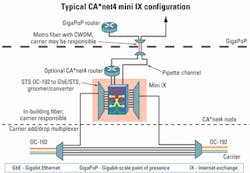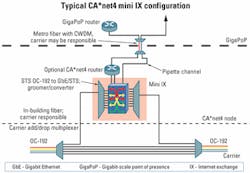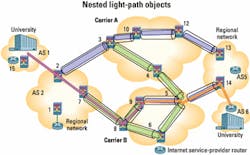CANARIE receives government funding for object-oriented 'Internet 2' network
By KATHLEEN RICHARDS
CA*net4, the successor to Canada's equivalent of the Internet 2 network for research and education, is on track for deployment by June 30. On Dec. 14, 2001, the nonprofit corporation CANARIE Inc. (Ottawa, Ontario), which is dedicated to the development of the advanced Internet in Canada, received a commitment of $110 million (Canadian) in funding from the Canadian government. Canada's existing advanced Internet, an IP-over-DWDM network known as CA*net3, will cease operation; its contract expires July 31.
Like its predecessor, CA*net4 will serve as a testing ground for new optical-networking applications, technologies, and concepts. The national optical IP network, roughly 16,000 km from St. John's, Newfoundland, to Victoria, British Columbia, is designed to function as an advanced Internet for roughly 80 universities, 30 research institutions, 50 colleges, 5,000 schools, and 50 hospitals. Initially, the network plan is for two OC-192 (10-Gbit/sec) wavelengths covering northern and southern routes. CA*net4 will interconnect 11 optical regional advanced networks in the provinces. Most of the regional networks own their own fiber. The most recent development on the regional front is a planned 3,200-km singlemode-fiber-based network in Ontario, known as the Ontario Research and Innovation Optical Network (ORION). A request for proposal for the project was issued Jan. 18.
Customer-owned light pathsThe major premise behind CA*net4 is object-oriented networking to support customer control of purchased wavelengths on the optical network. The network's optical architecture, currently being developed by a CANARIE design team, will eventually allow users to control and manage the routing, switching, and grooming of their own light paths across the network using an agent-based management system.Figure 1. Example of a possible switch architecture for CA*net4. An unprotected OC-192 wavelength from a carrier enters the switch or mini IX. The wavelength interface is provided through the carrier's transponder. It terminates at the CANARIE optical switch. The wavelength comprises several STS channels, which have been assigned to end users (initially CANARIE-operated gigabit points of presence). The proposed basic interface is Gigabit Ethernet, but the grooming device, which is part of the switch, establishes a connection's bandwidth.
A light path, as defined by the CANARIE design team, could mean traditional single-frequency wavelengths, STS channels, or subchannel implementations. The light path is fixed in bandwidth and cannot be merged or modified between two points on the network.
As the network is further developed, the customer who owns the light path would eventually be able to control its associated crossconnects remotely on a switch, allowing the customer to connect to other users' wavelengths and add or drop channels. Initially, the CANARIE-operated gigaPoPs will be considered the end users.
The wavelengths, or light paths, will be managed using a newly developed architecture. "Rather than having a centrally managed architecture using [Generalized] MPLS or UNI [user-network interface], we're developing our own protocol," says Bill St. Arnaud, CANARIE's senior director of advanced networks. The proposed protocol, which would allow users to crossconnect their light paths, is the optical border gateway protocol, and it is a variation of the Internet-standard border gateway protocol.
"The concept is that not only will the end users own and control their own light paths, they will own and control their own ports and a switch," explains St. Arnaud, "There is a lot of talk about bandwidth trading and wavelength trading; we are moving that to the next plane and creating what we call object-oriented networking, or OON, where the wavelength and the switch are objects that are owned and controlled by the end user."
User control of the optical network will allow research and educational facilities to, in effect, set up and tear down high-speed bandwidth connections to support collaborative projects in a "lambda grid," for example. These types of arrangements allow research facilities to control and exchange massive amounts of data and interconnect large databases.
As the network architecture develops, the plan is to eventually enable research facilities, other institutions, and individual researchers to purchase and manage their own optical light paths on a peer-to-peer basis. Yet, several technical challenges remain, particularly how the grooming devices or switches will interface with a proxy server to enable user control and signaling.
CA*net4 will also serve as an experimental network, enabling, for example, the testing of optical signaling techniques and software that supports OON. In addition, Canadian carriers and equipment suppliers can use the network to try out optical applications and technologies.
A request for information for CA*net4 was issued last August, prior to the funding announcement, to ensure timely deployment of the new network. At press time, CANARIE was in the final stages of negotiations with equipment suppliers for the switching/grooming box and with carriers. Legacy equipment from CA*net3 will not be used in the new network, according to St. Arnaud.
CA*net3, proposed and constructed in 1998, was a national network built with the help of a consortium of several vendors and one carrier. The consortium includes Bell Canada, Cisco Systems, JDS Fitel (now JDS Uni phase), Newbridge Networks (now Alcatel), and Nortel Networks.


